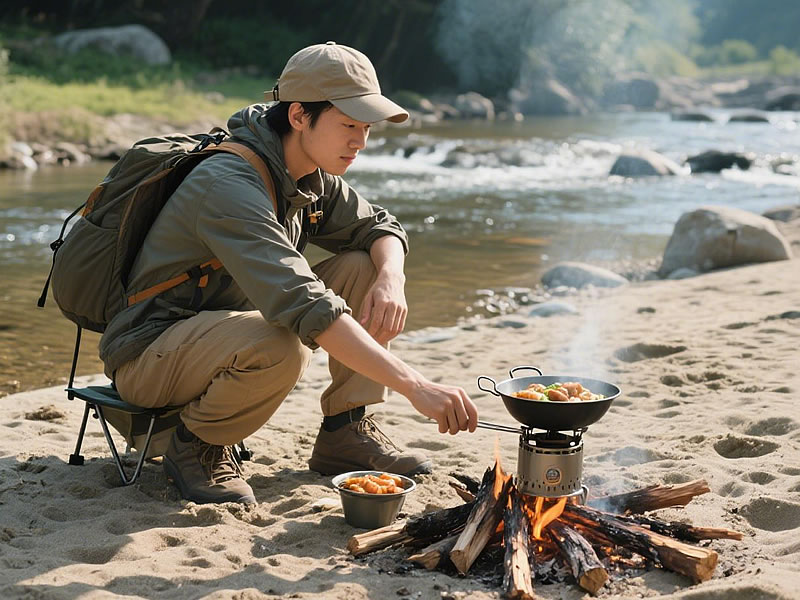Are wood-burning camping stoves worth it?
Wood-burning camping stoves have surged in popularity among eco-conscious adventurers, but their practicality depends on your camping style, location, and priorities. These stoves promise fuel-free cooking, but are they reliable enough for your next trip? Let’s dissect their benefits, limitations, and ideal use cases to help you decide.

The Pros: Why Go Wood-Burning?
- Eco-Friendly Operation:Burns renewable biomass (twigs, pinecones, leaves) instead of fossil fuels.Produces 90% less CO2 than propane stoves (University of Montana study).Leaves only biodegradable ash—no canisters to landfill.
- Unlimited Fuel Supply:Ideal for long expeditions where fuel resupply is impossible.Reduces pack weight for multi-day trips in forested areas.
- Survival Ready:Functions without commercial fuel—critical in emergencies.Doubles as a heat source in cold weather.
- Cost-Effective:No recurring fuel expenses after the initial purchase.
The Cons: Know the Drawbacks
- Weight and Bulk:Most models weigh 9–16 oz (e.g., Solo Stove Lite at 9 oz vs. 3 oz canister stoves).Bulkier designs (e.g., BioLite CampStove 2+) require more pack space.
- Weather Dependency:Struggles in rain or high humidity (wet wood won’t ignite).Useless in deserts or alpine zones above the treeline.
- Fire Restrictions:Banned in many parks during dry seasons or fire-prone regions (check CalFire alerts).
- Time-Consuming:Takes 5–15 minutes to boil 1L water vs. 2–3 minutes for gas stoves.
Wood Stove vs. Other Fuel Types: Quick Comparison
| Feature | Wood Stove | Propane | Alcohol |
|---|---|---|---|
| Fuel Cost | $0 (natural materials) | 5–5–15/canister | 10–10–20/liter |
| Eco-Footprint | Lowest | High (non-renewable) | Moderate |
| Boil Time | 8–15 mins | 2–5 mins | 6–10 mins |
| Best Environment | Forested areas | All-weather | Sheltered, low wind |
Top Wood-Burning Stoves of 2024
- Solo Stove LitePros: Smokeless gasification, ultralight (9 oz), no moving parts.Cons: No electricity generation.Best For: Minimalist backpackers in temperate forests.
- BioLite CampStove 2+Pros: Charges devices via USB, adjustable airflow, grill compatible.Cons: Heavy (2.06 lbs), expensive.Best For: Tech-loving campers needing off-grid power.
- Emberlit FireAntPros: Folds flat (credit card size), titanium construction.Cons: Requires external pot support.Best For: Survivalists and bushcrafters.
Pro Tips for Maximizing Efficiency
- Fuel Prep:Collect pencil-sized dry twigs—they ignite faster than thick logs.Use feather sticks (carved wood shavings) as firestarter.
- Weatherproofing:Coat wood with Vaseline for wet conditions.Pack a esbit dry fuel cube as backup.
- Ash Management:Scatter cold ash widely to fertilize soil (avoid dumping in water sources).
When to Avoid Wood Stoves
- High Fire Danger Areas: Check local bans at NIFC.gov.
- Leave No Trace Ethics: In heavily trafficked parks, use designated fire rings only.
- Speed-Cooking Needs: Large groups or quick breakfasts demand faster stoves.
FAQs
Q: Can I use wood stoves in bear country?
A: Yes, but store food separately—ash doesn’t attract bears, but cooking smells do.
Q: How to minimize smoke?
A: Use fully dried wood and ensure proper airflow (Solo Stove’s design reduces smoke by 90%).
Q: Are there hybrid wood/gas stoves?
A: Yes! TMS Portable Stove allows wood or propane use.
The Verdict: Who Should Buy One?
Wood-burning stoves are worth it if you:
- Camp in forested or rural areas with abundant biomass.
- Prioritize sustainability over speed.
- Want a survival-ready backup for emergencies.
Avoid them if you:
- Hike in deserts, tundras, or fire-restricted zones.
- Need fast, all-weather cooking for groups.
Final Thoughts
For eco-warriors and bushcraft enthusiasts, wood-burning stoves are a game-changer. Pair them with a gas stove for versatility—use wood for ambiance and gas for efficiency. Always respect fire bans, forage responsibly, and let the crackle of a wood fire deepen your connection to the wild.
Burn smart, tread lightly, and embrace the primal art of flame!






